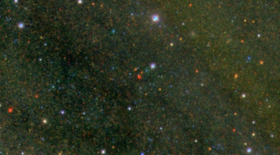Astronomy:LGGS J004431.71+415629.1
From HandWiki
Short description: Star in the constellation Andromeda
| Observation data Equinox J2000.0]] (ICRS) | |
|---|---|
| Constellation | Andromeda |
| Right ascension | 00h 44m 31.6652s[1] |
| Declination | 41° 56′ 28.965″[1] |
| Astrometry | |
| Radial velocity (Rv) | −12.4[2] km/s |
| Proper motion (μ) | RA: 138.8±0.2[1] mas/yr Dec.: 22.6±0.2[1] mas/yr |
| Parallax (π) | 12.4143 ± 0.1585[1] mas |
| Distance | 263 ± 3 ly (81 ± 1 pc) |
| Absolute magnitude (MV) | −6.2[3] |
| Details | |
| Radius | 1,508[3] R☉ |
| Luminosity | 300,600[3] L☉ |
| Temperature | 3,483[3] K |
| Other designations | |
| Database references | |
| SIMBAD | data |
Coordinates: ![]() 00h 44m 13.66s, +41° 56′ 28.9″
LGGS J004431.71+415629.1 is a possible red supergiant in the Andromeda Galaxy, and would be one of the largest stars known being 1,508 solar radii.
00h 44m 13.66s, +41° 56′ 28.9″
LGGS J004431.71+415629.1 is a possible red supergiant in the Andromeda Galaxy, and would be one of the largest stars known being 1,508 solar radii.
Possible foreground object
The star is mentioned in the original selection paper as being one of three (out of 354) "having velocities consistent with their actually being foreground stars". Although the colour of LGGS J004431.71+415629.1 makes it appear to be a red supergiant (RSG), it is described as being "right on the borderline between the separation of RSGs and foreground stars".[2]
See also
- WOH G 64
- UY Scuti
- Stephenson 2-18
References
- ↑ 1.0 1.1 1.2 1.3 1.4 Brown, A. G. A. (August 2018). "Gaia Data Release 2: Summary of the contents and survey properties". Astronomy & Astrophysics 616: A1. doi:10.1051/0004-6361/201833051. Bibcode: 2018A&A...616A...1G. Gaia DR2 record for this source at VizieR.
- ↑ 2.0 2.1 Massey, Philip; Evans, Kate Anne (2016). "The Red Supergiant Content of M31". The Astrophysical Journal 826 (2): 224. doi:10.3847/0004-637X/826/2/224. Bibcode: 2016ApJ...826..224M.
- ↑ 3.0 3.1 3.2 3.3 Gordon, Michael S.; Humphreys, Roberta M.; Jones, Terry J. (July 2016). "Luminous and Variable Stars in M31 and M33. III. The Yellow and Red Supergiants and Post-Red Supergiant Evolution". The American Astronomical Society 825 (1): 17. doi:10.3847/0004-637X/825/1/50. Bibcode: 2016ApJ...825...50G.
- ↑ "Simbad". Centre de Données astronomiques de Strasbourg. http://simbad.u-strasbg.fr/simbad/sim-id?Ident=LGGS+J004431.71%2B415629.1&submit=submit+id.


